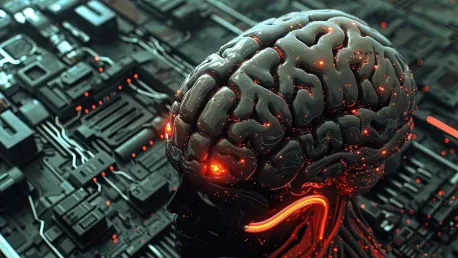The enigmatic nature of neural networks, central to modern artificial intelligence (AI) systems, is a significant challenge for researchers. Despite our substantial understanding of the mathematics that underpin these models, their intricate decision-making processes remain largely opaque. This lack of transparency poses numerous issues, especially as AI continues to integrate into high-stakes domains like healthcare and justice.
The Intricacies of Neural Networks
Opaque Decision-Making Processes
Neural networks, especially deep learning models, consist of layers of nodes and weights that process and transform input data into an output. Although we know the inputs and outputs, the pathways taken within these layers to reach a decision are often elusive. This opacity contrasts sharply with more interpretable AI algorithms like decision trees and linear regression, where decision paths can be easily traced and understood. In these simpler models, the specific steps and factors influencing the outcome are clear, making any predictions or recommendations they produce more reliable and easier to validate.
The lack of interpretability in neural networks can be attributed to their design and functionality. Deep learning models, for instance, emulate the complex functioning of the human brain through a multitude of layers, with each layer transforming the data in a way that is not easily decipherable. This transformation process, happening across potentially thousands of layers, results in outputs that cannot be easily traced back to the original inputs. The inherent complexity and non-linear decision-making processes of these networks make them a “black box,” where even developers struggle to understand how specific results are reached.
Complexity and Scale
A key factor contributing to this opacity is the sheer complexity and scale of neural networks. These models can contain thousands to trillions of parameters, creating an intricate web that makes it nearly impossible to provide a straightforward explanation for how they derive their results. The parameters, represented as weights within the network, are the result of extensive training on large datasets. For instance, OpenAI’s GPT-4, estimated to use around 1.8 trillion parameters, showcases the astronomical complexity involved in such advanced models. The sheer volume of these parameters adds another layer of difficulty in demystifying the decision-making processes of neural networks.
The complexity of neural networks poses not only interpretability challenges but logistical ones as well. The necessity to process and store vast amounts of data means that these networks require significant computational resources. Training such models is resource-intensive, demanding powerful GPUs and extensive time, often running into weeks or even months. Moreover, the dynamic nature of these models—continuously learning and adapting based on new data—further complicates the ability to pin down a static explanation for any given decision. This fluid aspect of neural networks, while enabling flexibility and improved performance over time, adds to the challenge of achieving transparent AI.
Challenges and Implications
Reliability and Safety Concerns
The complexity of neural networks doesn’t just impede understanding; it also raises significant challenges in detecting biases and correcting errors within these systems. This lack of transparency in decision-making can lead to distrust, especially in critical applications where reliability and safety are paramount. Verónica Bolón Canedo, an AI researcher, highlights that understanding these systems is vital for security and problem prediction. Without clarity on how decisions are made, ensuring their consistent and fair application becomes problematic. This issue becomes even more pronounced in areas like criminal justice, where biased or erroneous algorithmic decisions can have grave consequences.
The safety concerns surrounding neural networks are also tied to their unpredictability. As these models are trained on vast and diverse datasets, they may inadvertently learn and propagate existing human biases present in the data. Moreover, the “black-box” nature of these models means that even the developers have limited insight into the inner workings, making it difficult to identify and correct these biases promptly. The consequences can range from benign inconsistencies to severe misjudgments, particularly harmful when deployed in sensitive areas such as healthcare diagnostics or autonomous driving.
Regulatory Requirements
AI regulations, such as the EU AI Act, mandate transparency and explainability, particularly for high-risk applications. Developers are expected to provide comprehensible explanations for AI systems’ decisions. While some tools can interpret outputs, the primary concern remains the robustness and safety of these algorithms. This legislative perspective underscores the importance of maintaining control and ensuring the reliability of AI systems. Adherence to such regulations aims to prevent the deployment of opaque AI systems that could lead to unfair or unsafe outcomes, thereby fostering greater public trust in AI technologies.
Regulatory frameworks also emphasize accountability in AI development and deployment. By requiring clear and understandable explanations of AI decision-making processes, these regulations seek to make developers more responsible for their systems’ impacts. For example, in the medical field, a transparent AI system used for diagnosis can be audited for accuracy and bias, ensuring it meets stringent health standards before being widely adopted. This emphasis on transparency aligns with a broader ethical commitment to ensure that AI advancements benefit society without compromising safety and fairness.
Efforts to Decode Neural Networks
Methods and Approaches
Leading AI organizations, including OpenAI and the startup Anthropic, are actively working to decipher the behavior of their neural networks. For example, OpenAI employs one neural network to analyze another, while Anthropic examines the connections and circuits within nodes. These efforts focus on understanding the simplest components of these networks initially and scaling up as more insights are gained. By breaking down the neural networks into manageable segments, researchers hope to untangle the complex web of parameters and derive more coherent explanations for the outcomes produced by these models.
These methods aim to provide a more granular understanding of how individual nodes and connections contribute to the overall decision-making process. Essentially, researchers are creating a “map” of the neural network to pinpoint specific areas that need further scrutiny. This mapping process involves extensive experimentation and observation, often requiring sophisticated tools and techniques to trace how data flows and transforms through the network’s layers. While still in its early stages, this approach represents a significant step toward making these complex models more transparent and interpretable.
Initial Findings and Strategies
These approaches aim to mitigate issues such as inconsistent answers and hallucinations in language models. By identifying critical circuits that could pose safety risks, researchers hope to enhance the robustness and interpretability of these systems. Although the endeavor is far from straightforward, it represents a crucial step toward ensuring that AI applications are both effective and trustworthy. Initial findings from these efforts have shed light on some fundamental aspects of neural network behavior, providing valuable insights that could guide further refinement of these models.
One promising strategy involves designing “explainable AI” (XAI) frameworks beyond simply improving transparency. These frameworks incorporate various techniques, such as visualization and simplification, to help users and developers understand the model’s logic. For example, visualizing the activation patterns of specific layers and nodes can reveal the network’s decision pathways, offering more intuitive insights into its behavior. Additionally, simplifying the model by reducing the number of layers or parameters, without significantly impacting performance, can also make the network more interpretable and manageable.
Bridging the Gap Between Complexity and Transparency
Balancing Power and Reliability
Understanding and interpreting neural networks more effectively could yield significant benefits. For instance, improving transparency could help mitigate undesirable outcomes, like those seen in the problematic launch of Google Gemini. As it stands, testing and training these models remain empirical processes, guided by extensive training phases rather than complete understanding. Enhancing transparency in neural networks would not only boost their reliability but also foster greater trust among users and stakeholders, ensuring these powerful tools are used responsibly.
Balancing the power of these models with reliability involves developing robust evaluation metrics that can rigorously assess a model’s performance and transparency. These metrics must go beyond accuracy to evaluate factors such as fairness, explainability, and robustness to adversarial attacks. Additionally, fostering a culture of continuous monitoring and updating of these models can help to quickly identify and rectify any issues that arise post-deployment. This dynamic approach ensures the models remain reliable and aligned with ethical standards as they evolve.
Future Directions in AI Research
The cryptic nature of neural networks, which serve as the backbone for modern artificial intelligence (AI) systems, presents a considerable challenge for researchers. Although we have a solid grasp of the mathematical principles behind these models, their complex decision-making methods remain mostly obscured. This opacity introduces a slew of problems, particularly as AI becomes more integrated into critical fields like healthcare and justice. For instance, in healthcare, the stakes couldn’t be higher. Here, AI is used to diagnose illnesses, recommend treatments, and even predict patient outcomes. When these decisions are made, it’s essential for healthcare professionals to understand the rationale behind AI conclusions to trust and verify these life-altering recommendations. Similarly, in the justice system, where AI is deployed for tasks such as predicting recidivism or aiding sentencing decisions, the need for transparency is just as crucial. A lack of clear understanding can lead to issues of accountability and fairness, ultimately impacting people’s lives and freedoms. Therefore, unraveling the inner workings of neural networks is more than just an academic pursuit; it’s a pressing necessity for ensuring ethical and effective AI deployment.









